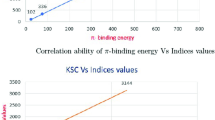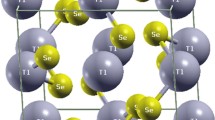Abstract
A numerical parameter, referred to as a topological index, is used for representing the molecular structure of a compound by analyzing its graph-theoretical characteristics. In the context of quantitative structure-activity relationship (QSAR) and quantitative structure-property relationship (QSPR) studies, topological indices serve as predictive tools for the physicochemical properties of chemical compounds. Graph entropies have evolved into information-theoretic instruments for exploring the structural information of molecular graphs. In this research, we compute the Nirmala index, as well as the first and second inverse Nirmala index, for the silicon carbide network \(Si_{2}C_{3}-III[\alpha ,\beta ]\), using its M-polynomial. The comparison of the Nirmala indices and corresponding entropy measures are presented through numerical computation and 2D line plots. A regression model is built to investigate the relationship between the Nirmala indices and corresponding entropy measures.
Similar content being viewed by others
Data Availability
No datasets were generated or analysed during the current study.
References
Wagner S, Wang H (2019) Introduction to Chemical Graph Theory, Discrete Mathematics and its Applications. CRC Press, Boca Raton
Trinajstic N (2018) Chemical Graph Theory. CRC Press, Boca Raton
Das S, Rai S, Kumar V (2023) On topological indices of Molnupiravir and its QSPR modeling with some other antiviral drugs to treat COVID-19 patients. J. Math. Chem. 1-44
Deng H, Yang J, **a F (2011) A general modeling of some vertex-degree based topological indices in benzenoid systems and phenylenes. Comput. Math. with Appl. 61:3017–3023
Wiener H (1947) Structural determination of paraffin boiling points. J Am Chem Soc 69:17–20
Randić M (1975) Characterization of molecular branching. J Am Chem Soc 97:6609–6615
Gutman I, Trinajstić N (1972) Graph theory and molecular orbitals. Total \(\pi \)-electron energy of alternant hydrocarbons. Chem Phys Lett 17:535–538
Das S, Rai S, Mandal M (2023) M-polynomial and correlated topological indices of antiviral drug Molnupiravir used as a therapy for COVID-19. Polycycl Aromat Compd 43:7027–7041
Kulli VR (2021) Nirmala index. Int. J. Math. Trends Technol. 67:8–12
Kulli VR, Lokesha V, Nirupadi K (2021) Computation of inverse Nirmala indices of certain nanostructures. International J. Math. Combin. 2:33–40
Hosoya H (1988) On some counting polynomials in chemistry. Discrete Appl. Math. 19:239–257
Verma A, Mondal S, De N, Pal A (2019) Topological properties of bismuth tri-iodide using neighborhood M-polynomial. Int. J. Math. Trends Technol. 67:83–90
Deutsch E, Klavžar S (2015) M-polynomial and degree-based topological indices. Iran. J. Math. Chem. 6:93–102
Kwun YC, Munir M, Nazeer W, Rafique S, Kang SM (2017) M-polynomials and topological indices of V-Phenylenic nanotubes and nanotori. Sci Rep 7:8756
Munir M, Nazeer W, Rafique S, Kang SM (2016) M-polynomial and related topological indices of nanostar dendrimers. Symmetry 8:97
Das S, Rai S (2020) M-polynomial and related degree-based topological indices of the third type of Hex-derived network. Nanosyst. Phys. Chem. Math. 11:267–274
Das S, Rai S (2020) M-polynomial and related degree-based topological indices of the third type of chain Hex-derived network. Malaya J. Mat. 8:1842–1850
Das S, Kumar V (2022) On M-polynomial of the two-dimensional silicon-carbons. Palest. J. Math. 11:136–157
Das S, Kumar V (2022) Investigation of closed derivation formulas for GQ and QG indices of a graph via M-polynomial. Iran. J. Math. Chem. 13:129–144
Das S, Rai S (2023) On closed derivation formulas of Nirmala indices from the M-polynomial of a graph. J Indian Chem Soc 100:101017
Shannon CE (1948) A mathematical theory of communication. Bell Syst Tech J 27:379–423
Huang R, Siddiqui MK, Manzoor S, Khalid S, Almotairi S (2022) On physical analysis of topological indices via curve fitting for the natural polymer of cellulose network. Eur. Phys. J. Plus 137:1–17
Wang XL, Siddiqui MK, Kirmani SAK, Manzoor S, Ahmad S, Dhlamini M (2021) On topological analysis of entropy measures for silicon carbides networks. Complexity 2021:1–26
Manzoor S, Siddiqui MK, Ahmad S (2022) On entropy measures of polycyclic hydroxy-chloroquine used for novel coronavirus (COVID-19) treatment. Polycycl Aromat Compd 42:2947–2969
Manzoor S, Siddiqui MK, Ahmad S (2020) On entropy measures of molecular graphs using topological indices. Arab J Chem 13:6285–6298
Hayat S (2024) Seham J F Alanazi and Jia-Bao Liu, Two novel temperature-based topological indices with strong potential to predict physicochemical properties of polycyclic aromatic hydrocarbons with applications to silicon carbide nanotubes. Phys Scr 99:055027
Hayat S, Mahadi H, Alanazi SJF, Wang S (2024) Predictive potential of eigenvalues-based graphical indices for determining thermodynamic properties of polycyclic aromatic hydrocarbons with applications to polyacenes. Comput Mater Sci 238:112944
Hayat S, Liu J-B (2024) Comparative analysis of temperature-based graphical indices for correlating the total \(\pi \)-electron energy of benzenoid hydrocarbons. J Mod Phys B. https://doi.org/10.1142/s021797922550047x
Hayat S, Khan A, Ali K, Liu J-B (2024) Structure-property modeling for thermodynamic properties of benzenoid hydrocarbons by temperature-based topological indices. Ain Shams Engineering Journal. 15:102586
Hayat S (2023) Distance-based graphical indices for predicting thermodynamic properties of benzenoid hydrocarbons with applications. Comput Mater Sci 230:112492
Hayat S, Suhaili N, Jamil H (2023) Statistical significance of valency-based topological descriptors for correlating thermodynamic properties of benzenoid hydrocarbons with applications. Comput Theor Chem 1227:114259
Chen Z, Dehmer M, Shi Y (2014) A note on distance-based graph entropies. Entropy 16:5416–5427
Kumar V, Das S (2023) On Nirmala Indices-based Entropy Measures of Silicon Carbide Network. Iran. J. Math. Chem. 14:271–288
Funding
No funding is available for this study.
Author information
Authors and Affiliations
Contributions
All authors have contributed equally to the work done in the paper.
Corresponding author
Ethics declarations
Conflicts of interest
The authors declare that they have no known competing financial interests or personal relationships that could have appeared to influence the work reported in this paper.
Competing interests
The authors declare no competing interests.
Additional information
Publisher's Note
Springer Nature remains neutral with regard to jurisdictional claims in published maps and institutional affiliations.
Rights and permissions
Springer Nature or its licensor (e.g. a society or other partner) holds exclusive rights to this article under a publishing agreement with the author(s) or other rightsholder(s); author self-archiving of the accepted manuscript version of this article is solely governed by the terms of such publishing agreement and applicable law.
About this article
Cite this article
Shilpa, H.C., Gayathri, K., Dharmendra, B.N. et al. On Nirmala Indices-based Entropy Measures of Silicon Carbide Network \(Si_{2}C_{3}-III[\alpha ,\beta ]\). Silicon (2024). https://doi.org/10.1007/s12633-024-03071-z
Received:
Accepted:
Published:
DOI: https://doi.org/10.1007/s12633-024-03071-z




